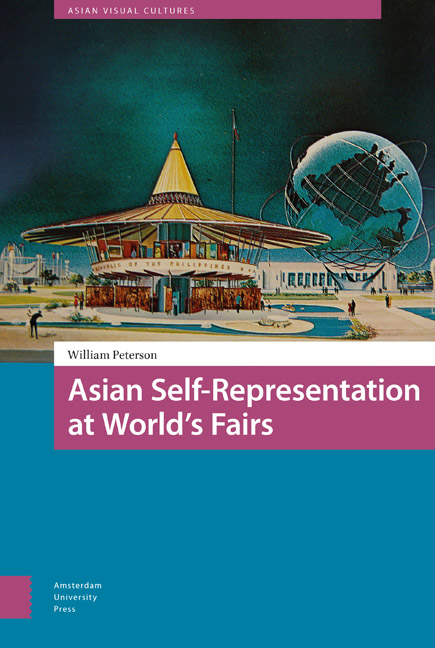Book contents
- Frontmatter
- Dedication
- Contents
- List of Figures
- Acknowledgements
- Note on Works Cited
- Note on Asian Names
- 1 Introduction: Setting the Stage
- 2 The Master of the Form: Japan at San Francisco's 1915 Panama-Pacific International Exposition
- 3 The New China and Chinese-Americanness: China at San Francisco's 1915 Panama-Pacific International Exposition
- 4 Performing Japan in the ‘World of Tomorrow’: Japan at the 1939-1940 New York World's Fair
- 5 From ‘Panda Diplomacy’ to Acrobat Diplomacy: China at the Brisbane's Expo ‘88
- 6 Fashion, Dance, and Representing the Filipina: The Philippines at the 1964-1965 New York World's Fair
- 7 Performing Modernity under Sukarno's ‘Roving Eye’: Indonesia at the 1964-1965 New York World's Fair
- 8 Maximizing Affect, Minimizing Impact with Hansik: South Korea at the 2015 Milan International Exposition
- 9 Hard and Soft Power in the Thai Pavilion: The Spectral Presence of King Bhumibol at the 2015 Milan Exposition
- 10 Conclusion: The Future of Asian Self-Representation at the International Exposition
- Works Cited
- Index
1 - Introduction: Setting the Stage
Published online by Cambridge University Press: 21 November 2020
- Frontmatter
- Dedication
- Contents
- List of Figures
- Acknowledgements
- Note on Works Cited
- Note on Asian Names
- 1 Introduction: Setting the Stage
- 2 The Master of the Form: Japan at San Francisco's 1915 Panama-Pacific International Exposition
- 3 The New China and Chinese-Americanness: China at San Francisco's 1915 Panama-Pacific International Exposition
- 4 Performing Japan in the ‘World of Tomorrow’: Japan at the 1939-1940 New York World's Fair
- 5 From ‘Panda Diplomacy’ to Acrobat Diplomacy: China at the Brisbane's Expo ‘88
- 6 Fashion, Dance, and Representing the Filipina: The Philippines at the 1964-1965 New York World's Fair
- 7 Performing Modernity under Sukarno's ‘Roving Eye’: Indonesia at the 1964-1965 New York World's Fair
- 8 Maximizing Affect, Minimizing Impact with Hansik: South Korea at the 2015 Milan International Exposition
- 9 Hard and Soft Power in the Thai Pavilion: The Spectral Presence of King Bhumibol at the 2015 Milan Exposition
- 10 Conclusion: The Future of Asian Self-Representation at the International Exposition
- Works Cited
- Index
Summary
Abstract
The chapter sets out the rationale for and structure for this inquiry into Asian self-representation at World's Fairs, or international expositions. Using a case-studies approach, the book will consider how independent Asian nations have sought to shape and control the ways in which they were represented at these events. China and Japan at the San Francisco Panama Pacific International Exposition in 1915 are the focus of the first two chapters, followed by Japan in at the 1939-1940 New York World's Fair, and China at Expo ‘88 in Brisbane. Other fairs and nations examined in the 100-year span of this inquiry include the 1964-1965 New York World’s Fair (the Philippines and Indonesia) and the 2015 Milan International Exposition (Thailand and Korea).
Keywords: exhibition, exposition, performativity, representation
International expositions remain the largest and most important stage on which millions of humans routinely gather to experience, express, and respond to cultural difference. The London Crystal Palace Exhibition of 1851, regarded as the first of what later became known as ‘world fairs,’ evidenced features that were later to become standard, and was largely a national trade show, with Asia represented primarily through the display of objects, chiefly from British-colonized India. By the time of the 1889 Paris Exposition Universelle and the 1893 Chicago Exposition, these mass events presented opportunities for fairgoers not just to look at objects, but to gaze upon humans from far-flung, colonized lands, as foreign bodies increasingly constituted a key audience attraction. During the ‘golden age’ of the exposition which lasted until World War I, these human encounters, many of them staged in virtual villages such as the Cairo Street at the 1889 Paris Exposition or the Philippines Reservation at the 1904 Saint Louis Exposition, were presented as authentic reproductions of life ‘back home,’ making villagers available to fairgoers to be scrutinized, evaluated, and judged as they carried out the activities of daily life.
- Type
- Chapter
- Information
- Asian Self-Representation at World's Fairs , pp. 15 - 38Publisher: Amsterdam University PressPrint publication year: 2020



